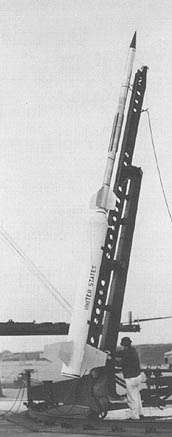Nike-Cajun

The Nike-Cajun was a two-stage sounding rocket built by combining a Nike base stage with a Cajun upper stage. It was launched 714 times between 1956 and 1976 and was the most frequently used sounding rocket of the western world. The Nike Cajun had a launch weight of 698 kg (1538 lb), a payload of 23 kg (51 lb), a launch thrust of 246 kN (55,300 lbf) and a maximum altitude of 120 km (394,000 ft). It had a diameter of 42 cm (1 ft 4½ in) and a length of 7.70 m (25 ft 3 in). The maximum speed of the Nike-Cajun was 6,760 km/h (4,200 mph).
The Cajun stage of this rocket was named for the Cajun people of south Louisiana because one of the rocket's designers, J. G. Thibodaux, was a Cajun.
The Nike-Cajun configuration was also used by one variation of the MQR-13 BMTS target rocket.[1]
Engine:
- 1st stage: Allegheny Ballistics Lab. X216A2 solid-fueled rocket; 246 kN (55,000 lb) for 3 s
- 2nd stage: Thiokol TE-82-1 Cajun solid-fueled rocket; 37 kN (8,300 lb) for 2.8 s
References
- ↑ Parsch 2002
- http://www.astronautix.com/lvs/nikcajun.htm
- Parsch, Andreas (2002). "USAMICOM MQR-13 BMTS". Directory of U.S. Military Rockets and Missiles. designation-systems.net. Retrieved 2011-01-06.